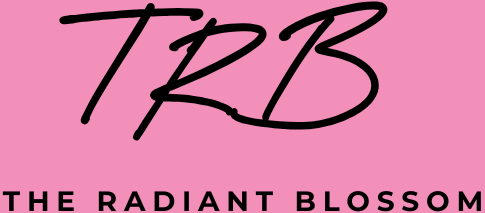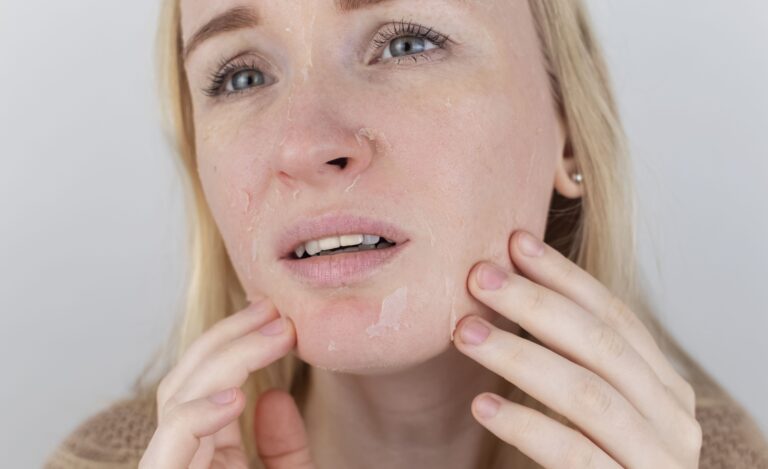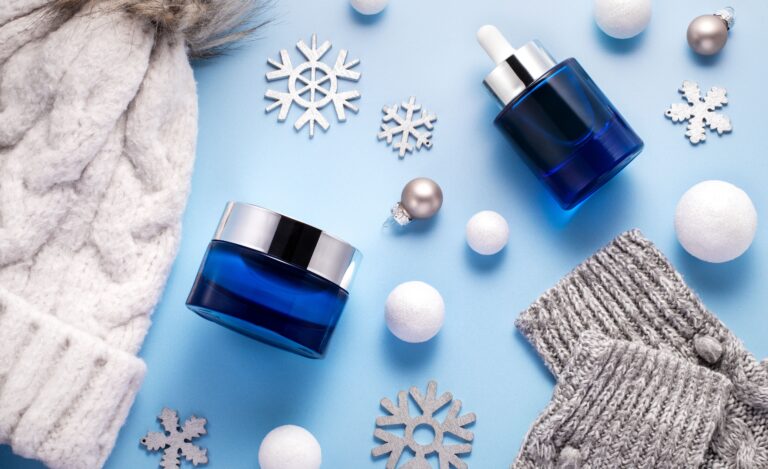Let’s face it—skincare can feel overwhelming. With so many creams, serums, toners, and masks (each promising to change your life), it’s easy to get lost. But the truth is, taking care of your skin doesn’t have to be complicated or expensive. In fact, a simple and consistent skincare routine is often the most effective way to achieve healthy, glowing skin.
This guide is designed for beginners—whether you’re completely new to skincare or just tired of overcomplicated routines. We’ll break down the essentials, explain why each step matters, and help you build a routine that works for you and your unique skin.
By the end, you’ll have the confidence to take care of your skin without the stress, hype, or guesswork.
Understanding Your Skin
Before you dive into products and routines, the most important step when you start your routine is to understand your skin. Knowing your skin type will help you choose the right products, avoid irritation, and build a routine that works.
The 5 Basic Skin Types
- Normal Skin
- Balanced—neither too oily nor too dry
- Smooth texture, few imperfections
- Minimal sensitivity
- Dry Skin
- Feels tight or rough, especially after washing
- May flake or appear dull
- Prone to irritation and redness
- Oily Skin
- Produces excess sebum (oil)
- Often shiny, especially in the T-zone (forehead, nose, chin)
- Prone to clogged pores and acne
- Combination Skin
- Oily in some areas (usually T-zone), dry or normal in others
- Can be tricky to balance
- Needs tailored care for different areas
- Sensitive Skin
- Easily irritated by products, weather, or stress
- May sting, burn, or become red after product use
- Requires gentle, soothing ingredients
How to Identify Your Skin Type
Clean Face Test: Wash your face with a gentle cleanser, pat dry, and wait 30–60 minutes without applying any products.
- If your skin feels tight or flaky → dry
- If it looks shiny all over → oily
- If only your T-zone is shiny → combination
- If it feels balanced and calm → normal
- If you experience redness or discomfort → sensitive
Why Skin Type Matters
Each skin type has different needs:
- Dry skin benefits from richer creams and hydrating ingredients like hyaluronic acid.
- Oily skin may prefer lightweight, oil-free formulas and gentle exfoliants.
- Sensitive skin requires fragrance-free, minimal-ingredient products.
- Knowing your skin type prevents you from wasting money on products that could make things worse.
The Core Skincare Routine for Beginners (3-Step Method)
If you’re new to skincare, start with the basics. A solid routine doesn’t need 10 products—just three key steps that, when done consistently, will make a big difference:
Step 1: Cleanse (Clean Your Skin)
Why it matters: Cleansing removes dirt, sweat, oil, makeup, and pollution that can clog pores or cause breakouts. Therefore your skincare routine should always start with this. Clean skin also helps the rest of your products absorb better.
How to do it:
- Use a gentle cleanser morning and night.
- Massage into damp skin for about 30–60 seconds.
- Rinse with lukewarm water (avoid hot water—it can strip your skin).
Types of cleansers:
- Gel Cleanser – Great for oily/combo skin; deeply cleanses.
- Cream Cleanser – Ideal for dry/sensitive skin; more hydrating.
- Foam Cleanser – Light and effective; may be drying for some.
- Micellar Water – Good for quick or no-rinse cleansing, especially for sensitive skin.
How to Choose a Cleanser:
- Oily Skin: Look for a gel or foaming cleanser with ingredients like salicylic acid to help control oil and prevent breakouts.
- Dry Skin: Opt for a hydrating cream or balm cleanser with ingredients like hyaluronic acid or glycerin to maintain moisture.
- Combination Skin: Use a gentle, balanced cleanser that removes oil without drying the skin.
- Sensitive Skin: Choose a fragrance-free, non-irritating cleanser with soothing ingredients like centella asiatica or chamomile.
How often? Cleanse twice daily (morning and night). If your skin is very dry, you can cleanse with just water in the morning.
Step 2: Moisturize (Hydrate and Protect Your Barrier)
Why it matters: Moisturizer is essential for keeping your skin barrier healthy and preventing water loss by locking in hydration. Don’t skip this step, even if you have oily skin!
How to do it:
- Apply moisturizer while your skin is still slightly damp (after cleansing).
- Use a lighter lotion or gel in the morning, and a richer cream at night if needed.
Types of moisturizers:
- Gel-based – Lightweight, good for oily or acne-prone skin.
- Cream-based – Thicker, good for dry or mature skin.
- Lotion – A balanced option for normal or combo skin.
How to Choose a Moisturizer:
- Oily Skin: A lightweight, oil-free gel or water-based moisturizer.
- Dry Skin: A richer cream with ceramides, shea butter, or hyaluronic acid.
- Combination Skin: A gel-cream that hydrates without feeling greasy.
- Sensitive Skin: A gentle, fragrance-free moisturizer with calming ingredients.
How often? Apply morning and night after cleansing.
Step 3: Protect (Sunscreen is Non-Negotiable)
Why it matters: UV damage is the #1 cause of premature aging, hyperpigmentation, and skin cancer. Therefore sunscreen is the most important part of any routine. Use it even if it’s cloudy, even if you’re indoors—UV rays are sneaky.
How to do it:
- Use a broad-spectrum SPF 30 or higher every single morning.
- Apply as the last step in your routine.
- Don’t forget your ears, neck, and hands.
Tip: Look for sunscreen that suits your skin type (gel-based for oily skin, hydrating for dry/sensitive skin). And no, SPF in makeup isn’t enough!
How to Choose a Sunscreen:
- Look for SPF 30 or higher.
- Choose between chemical or mineral sunscreens:
- Chemical sunscreens absorb UV rays and feel lightweight.
- Mineral sunscreens (with zinc oxide or titanium dioxide) sit on top of the skin and are great for sensitive skin.
- Non-comedogenic formulas are best for acne-prone skin.
How often? Apply every morning, even if it’s cloudy or you’re indoors. Reapply every 2 hours if outside.
Optional Add-Ons Once Comfortable
Once you’ve established a consistent core routine, you might want to explore additional steps to address specific concerns like dullness, acne, uneven tone, or aging. These steps are totally optional and should be introduced one at a time to avoid overwhelming your skin.
a. Exfoliants (2–3x per week MAX)
Purpose:
Exfoliating removes dead skin cells, unclogs pores, boosts skin radiance, and improve texture.
Types:
- Chemical Exfoliants (gentler and more effective for most skin types):
- AHAs (e.g., glycolic acid, lactic acid) – Great for dry or dull skin
- BHAs (e.g., salicylic acid) – Best for oily, acne-prone skin
- Physical Exfoliants (scrubs with granules or brushes):
- Use with caution; can be too harsh for sensitive skin
Tips:
- Start with 1x per week and see how your skin reacts
- Avoid using exfoliants on broken or irritated skin
- Don’t mix strong exfoliants with other actives like retinol right away
b. Serums (Targeted Treatments)
Purpose:
Serums are lightweight and packed with concentrated active ingredients that target specific concerns like acne, dark spots, or fine lines.
Popular beginner-friendly serums:
- Vitamin C – Brightens, evens skin tone, and protects against free radicals. Best used in the morning.
- Hyaluronic Acid – Hydrates and plumps skin.
- Niacinamide – Calms inflammation, reduces oil, and smooths texture
- Azelaic Acid – Soothes redness and helps with acne or pigmentation
- Retinol – Great for anti-aging. It can only be use at night.
Tip: Introduce one serum at a time and use it after cleansing, before moisturizing.
c. Eye Creams (Optional)
Purpose:
Designed for the delicate skin around your eyes to reduce puffiness, dark circles, or fine lines.
When to use it:
- After serums but before moisturizer (if you choose to use one)
Reality check:
A regular moisturizer often works just fine here—eye creams are optional unless you’re targeting a specific concern.
d. Face Oils
Purpose:
Adds an extra layer of nourishment, especially in dry or cold climates.
Who it’s for:
- Dry, mature, or dehydrated skin types
- Nighttime use is best
Tip: Use oils after moisturizer to lock in hydration (or mix a few drops into your moisturizer).
Pro Tip: Start slow. Introduce one new product at a time, and give it 1–2 weeks to observe how your skin responds. This helps you avoid irritation and figure out what’s actually working.
Tips for Choosing Skincare Products
With shelves (and feeds) overflowing with skincare options, it’s easy to feel overwhelmed. Here’s how to simplify the process and make choices that suit your skin, goals, and budget.
1. Read Ingredient Labels (And Don’t Panic)
Focus on key active ingredients relevant to your skin needs:
- Dry skin? Look for hyaluronic acid, ceramides, glycerin
- Oily or acne-prone? Try salicylic acid, niacinamide, or zinc
- Uneven tone? Go for vitamin C, azelaic acid, or licorice root
Avoid buzzword chasing—fewer, effective ingredients often work better.
2. Less Is More (Especially at First)
Start with basic, no-frills formulas. Your skin doesn’t need a dozen actives at once. Let it adjust before layering on too much.
3. Avoid Fragrances and Harsh Ingredients (If You’re Sensitive)
- Fragrance, essential oils, and alcohol can irritate sensitive or reactive skin.
- Look for products labeled fragrance-free, alcohol-free, or for sensitive skin.
4. Look for “Non-Comedogenic” (Especially if You Break Out)
This means the product is less likely to clog pores, a must for acne-prone skin. Not a guarantee, but a helpful filter.
5. Do a Patch Test
Before using a new product on your face:
- Apply a small amount to your inner forearm or behind your ear.
- Wait 24–48 hours to see if irritation occurs. It’s a simple step that can save your skin from major drama.
6. Price ≠ Quality
You don’t have to splurge for effective skincare.
- Affordable gems: CeraVe, The Ordinary, La Roche-Posay, Neutrogena, Simple
- What matters more: formulation and ingredient quality—not fancy packaging
7. Know Your Priorities
Ask yourself:
- What’s my skin type?
- What’s my biggest concern (e.g. dryness, acne, dullness)?
- What’s my budget? This will help narrow your options quickly.
Pro Tip: Skincare is personal. What works for your friend, your favorite influencer, or even your dermatologist might not work for you—and that’s okay.
Common Beginner Mistakes to Avoid
Even with the best intentions, skincare newbies often fall into a few classic traps. Here’s what to watch out for so your journey starts off smooth (literally and figuratively).
1. Over-Exfoliating
It’s tempting to scrub your way to glass skin, but too much exfoliation can damage your skin barrier and cause redness, peeling, or breakouts.
- Limit exfoliation to 1–3 times per week
- Never mix multiple exfoliants or use them daily—especially when starting out
2. Using Too Many Products at Once
Skincare isn’t a race. Adding five new products in one week? That’s a recipe for confusion and irritation.
- Introduce new products one at a time, with a few days to a week between
- Don’t follow a 10-step routine unless you know your skin loves every step
3. Skipping Sunscreen
This is the #1 skincare sin. You can use the best products in the world—but if you’re not protecting your skin from UV rays, it’s all for nothing.
- Wear SPF 30 or higher every single morning
- Don’t rely on SPF in foundation or moisturizer alone—it’s not enough
4. Not Being Patient
Skin takes time to adjust and heal. Most products need 4–6 weeks (or longer) to show real results.
- Stick with a routine for at least a month before switching things up
- Don’t jump ship if you don’t see changes overnight
5. Ignoring Skin Reactions
That tingling, burning, or flaking feeling? Not always a “sign it’s working.”
- Listen to your skin—redness, stinging, or tightness are red flags
- Don’t “push through” discomfort just to follow a trend
6. Using Products Meant for Different Skin Types
Dry skin using astringent toner? Oily skin drowning in heavy creams?
- Match your products to your actual skin type and current concerns
- Don’t assume one-size-fits-all—what works for someone else may not work for you
7. Chasing trends without doing research
If it’s all over TikTok and Instagram, but makes zero sense for your skin, most probably it is not worth it.
Building a Routine That Works for You
There’s no universal routine that works for everyone. The key is to create a simple, realistic skincare routine that suits your skin, your lifestyle, and your comfort level. Here’s how to build something sustainable (and actually enjoyable).
Start Simple, Stay Consistent
- Begin with the basics: Cleanser → Moisturizer → Sunscreen (morning), and just Cleanser → Moisturizer (night).
- Stick to this for a few weeks before adding extras.
- Think of skincare as a marathon, not a sprint.
Listen to Your Skin (Not Just Trends)
- Is your skin feeling tight? Try a richer moisturizer.
- Getting breakouts? Look at your ingredients or introduce a gentle exfoliant.
- Burning or redness? Scale back and go fragrance-free.
Let your skin tell you what it needs—and trust it.
Adjust Seasonally
Your skin can behave differently in summer vs. winter:
- Winter: You may need thicker moisturizers and gentler cleansers.
- Summer: Lighter textures, mattifying products, and more diligent SPF reapplication.
Stay flexible and tweak things based on weather, environment, or travel.
Use a Skincare Journal (Optional but Helpful)
Track what you’re using and how your skin responds. It helps you:
- Spot patterns (what’s working, what’s not)
- Avoid repeating mistakes
- See progress over time
Even a few quick notes in your phone can go a long way.
Know When to Adjust
- New skin concerns arise (acne, dryness, etc.) → evaluate your routine
- No improvement after 6–8 weeks → consider swapping or adding products
- Skin feels irritated → simplify and focus on soothing, repairing the skin barrier
Reminder: There’s no “perfect” routine—only the one that works for you.
When to See a Dermatologist
Skincare routines can do a lot—but not everything. Sometimes, what your skin really needs is a trained professional. Knowing when to ask for help can save you a lot of time, money, and frustration.
Signs It’s Time to See a Dermatologist
Persistent or Severe Acne
- If over-the-counter treatments aren’t working
- Painful cysts, scarring, or acne that won’t quit
- You may need prescription treatments (like retinoids or antibiotics)
Chronic Skin Irritation
- Constant redness, burning, or itching
- Rashes that come and go
- Could be eczema, contact dermatitis, or a product allergy
Unexplained Skin Changes
- Sudden pigmentation changes
- Moles that change in size, shape, or color
- Any new or changing spots that itch, bleed, or look unusual
(Get these checked ASAP)
Skin Conditions That Won’t Improve
- Rosacea, psoriasis, melasma, or fungal infections
- These often need diagnosis and targeted treatments
You Just Feel Stuck
- If you’ve tried everything and nothing seems to help
- A derm can help you figure out your skin type, triggers, and an effective plan
Final Tips for Beginners
- Keep it simple. Don’t buy too many products at once—start with the basics and introduce new products gradually.
- Be consistent. Skincare is about patience! Results take time, usually 4-8 weeks.
- Listen to your skin. If a product causes irritation, stop using it and simplify your routine.
By following these three essential steps—cleansing, moisturizing, and sunscreen—you’ll build a strong foundation for healthier, glowing skin. Once you’re comfortable, you can explore more targeted treatments based on your skincare goals!
What’s your biggest skincare challenge? Drop your questions in the comments!




